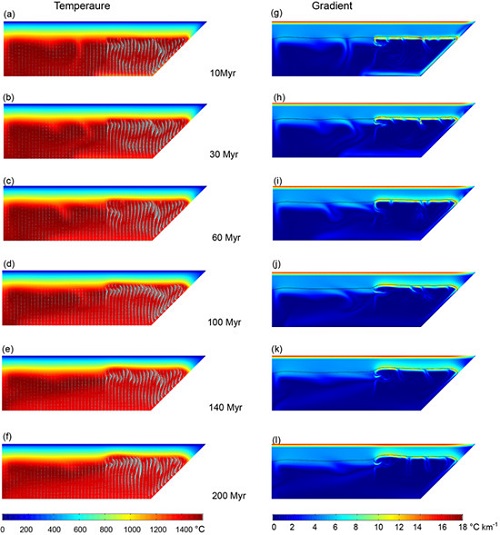From a geothermal point of view, areas of cratonic lithosphere are stable when surface heat flow is in equilibrium with the heat supply at the base of the lithosphere plus the heat generated by radioactive decay within the lithosphere. Archean craton is usually characterized as cold and in thermal equilibrium. Destruction of the craton refers to the disturbance of this thermal equilibrium. Since there is a lack of evidence for a plume in the eastern North China Craton (NCC) during the Mesozoic, the heat source responsible for NCC destruction is a critical point against the thermal erosion model. In recent years, the deep subduction of the Pacific Plate underneath East Asia is thought to have played a key role in the destruction of the NCC and a conceptual model has been proposed that needs further testing through numerical simulations.
He (2014) presents a new 2-D model to test this proposed mechanism of NCC destruction. The model includes an initial stable equilibrated craton, the formation of a big mantle wedge (BMW), and erosion by vigorous mantle convection. The model contains a solid lithosphere domain and a fluid asthenosphere domain. The bottom of the lithosphere is defined by an isotherm, and the viscosity of the model is infinite at temperatures lower than this isotherm.
The model indicates that subduction alone cannot thin the cold solid craton, but it can form a low-viscosity BMW. The decreasing viscosity causes the Rayleigh number to increase, which leads to more vigorous convection within the BMW (Figure 1). As a result, the top of the asthenosphere moves upward. This causes significant compression of the rheological boundary layer (RBL) and forms a thin layer with an anomalously high thermal gradient immediately beneath the lithosphere. Conductive heat flow at the base of the lithosphere increases and the original thermal balance is broken, with mantle convection supplying more heat than can be removed by conduction of the lithosphere and causing thinning of the lithosphere by heating (Figure 1). Thus, the lithosphere could be significantly thinned at normal asthenospheric temperatures. Such thermal erosion is realized though compressing the RBL rather than requiring an extra heat source. The amount of convective erosion is directly proportional to viscosity within the BMW (η0bmw), and the rheological boundary layer thins linearly with decreasing log10(η0bmw), thereby contributing to an increase in heat flow at the lithospheric base. Moreover, the lowering of melting temperature by peridotite-melt interaction can accelerate thinning during the early stages of this convection. The two combined actions can thin the craton significantly over tens of Myr。

Fig.1. Distribution of temperature and temperature gradient at η0bmw=1019 Pa s.
Journal of Geophysical Research (He et al. Numerical modeling of convective erosion and peridotite–melt interaction in big mantle wedge: implications for the destruction of the North China Craton. Journal of Geophysical Research, 2014, 119(4) : 3662-3677 (Link)